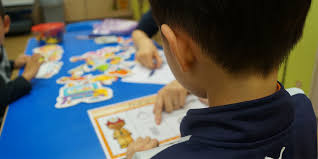Subject Code & Title: CHCECE023 Child Development Analyse Information To Inform Learning
Requirements
To complete this assessment activity, you need:
A.access to a regulated children’s services environment
B. access to the National Quality Framework and National Quality Standard
C. access to the relevant approved learning framework
D. answer the questions and submit your responses
Purpose :
This assessment activity is designed to assess your skills and knowledge in gathering and documenting information about children.
CHCECE023 Child Development Analyse Information To Inform Learning Assessment – Australia.

Instructions :
For this Assessment, you are required to observe three (3) separate children and collect specific information about their background and learning. Select children from different age groups if possible. Prepare a file for each child. You will add to these files in the assessment activities as you progress through the assessments. Remember to maintain confidentiality at all times. In particular, in any documentation, use only a child’s first name to protect their identity.
Questions :
1. Create a profile for each child that includes:
• family background
• interests and play preferences
• strengths
• relationships
• developmental level.
You should collect information from:
• the family
• other people close to the child
• the child
• other children
• educators
• relevant professionals/specialists (if appropriate)
You will create three (3) separate profiles in total – that is one for each child. Upload your response in one file.
2.You are required to take observations of each of the children. The observations will include an interpretation. Build up observation records for each child over a period of time and in a variety of spaces.
Identify the child’s progress toward the five EYLF Outcomes by focusing on:
1.the child’s sense of identity
2. the child’s connection to their world
3. the child’s sense of wellbeing
4. the child as a confident and involved learner
5. the child as an effective communicator.
Use at least four (4) of the following methods to gather and record information:
1. Secondary sources such as discussions with others, communication books, incident reports and samples of work
2. Jottings
3.Anecdotal information
4. Time samples and running records
5. Questioning
6. Event samples and checklists
7. Sociograms
8. Webs
9. Learning stories
10. Information and communication technology
CHCECE023 Child Development Analyse Information To Inform Learning Assessment – Australia.

3.Use the records of the three children you have observed to create and provide a short assessment of each child
1. Include the voice of others in the assessment.
2. Focus on how the record demonstrates the child’s progress toward the five EYLF Outcomes.
List each EYLF Outcome and document your short assessment (3 or 4 sentences for each Outcome) An example of how to set this response out would be as follows::
Child 1: Anna
Outcome 1: Anna shows secure attachments with Educators and peers etc…
Outcome 2:
Outcome 3:
Outcome 4:
Outcome 5:
4. For each child, use dot-points to describe how:
1.You have collected information over enough time and in a number of spaces to give you an accurate view of the child.
2. Your assessments meet the assessment principles: valid, representative, significant and relevant.
3. You used inclusive assessment practices.
You may wish to use a table similar to the following to complete this question. Remember to do this for each of the three (3) children.


5. Complete the following two tasks.
a) For each child, use a format of your choice to complete a summative assessment that links to the EYLF Outcomes and represents each child’s:
1.strengths
2. interests and/or play preferences
3. relationships
4.learning
5. need for additional support to meet an EYLF Outcome.
b) Share your summative assessments with a colleague and the children’s parents. Ask for their feedback on your assessment and see if there is any further information you can gather from them. Record this feedback.
6. Refer to scenario 1 below to answer the following question: Develop a process that Linda could use to ensure that each child is observed and suitable information is gathered to make the curriculum responsive and inclusive.
7. Refer to scenario 1 below to answer the following question: What should Linda do if the assessment of information from this process indicates a child needs additional support to achieve a learning outcome?
Linda is a Diploma-qualified educator working in a room with 27 children and two other educators. The children are aged between 4 and 5 years old and from a range of backgrounds. They all speak and understand English well. The children usually attend between 9.00 am and 3.00 pm
8. Use your formative and summative assessments to develop a plan with two experiences for each of the three children (that is, six (6) activities in all). For each child, include:
1. an intentional teaching experience
2.a planned ‘learning through play’ experience.
For each of the six (6) experiences, your plan should describe:
a.which type of experience it is (intentional or learning through play)
b. what the planned activity is
c. how you will set up the environment to encourage participation and learning
d.how you will ensure the children are comfortable by creating a safe and non-threatening space
e.an outcome, goal and objective for the activity
f. modelling that is planned as part of the activity
g. the materials and resources needed.
(Note that you have already recorded the children’s strengths, interests, relationships, play preferences and needs in Assessment activity 2.)
Use a table similar to the following or the service’s template.


8. Use at least three methods to critically reflect on and improve your practice. Briefly describe:
1.the methods you used
2.what you found out
3.how you plan to improve your performance.
9. Provide an example of a situation you have reflected on where you\ believe you could have reacted better.
Answer these questions.
1. What happened?
2. Why did it happen?
3. How did it happen?
4.How do you feel about it?
5. What have you learnt from this?
6. What is the significance of this?
7. What will you do next?
8. How will this alter your future actions and values?
CHCECE023 Child Development Analyse Information To Inform Learning Assessment – Australia.

10. Continue with the three children you worked with in assessment activities 1, 2 and 3. Use appropriate strategies to share a piece of documentation of your choice (a sample of the child’s work, activity plans, enrolment information/planning file, summative assessment) with the family of each child. For each family (3 in total), explain in one or two sentences:
1. the type of documentation you shared
2. the strategy used to communicate the information in the documentation
3. why you shared this particular documentation
4.how you ensured privacy (when appropriate) for the parents when sharing the information in the documentation.
11. Describe three methods for ensuring that information shared with families is kept private.
12. Explain in one or two sentences why it is essential to follow confidentiality practices to ensure information is shared appropriately.
13. Give two (2) reasons why documentation about a child’s program and progress must be made available to their family. You may refer to the relevant NQS Elements to support your answer.



